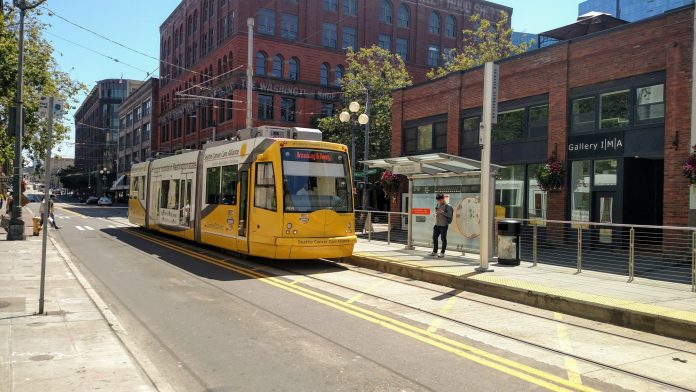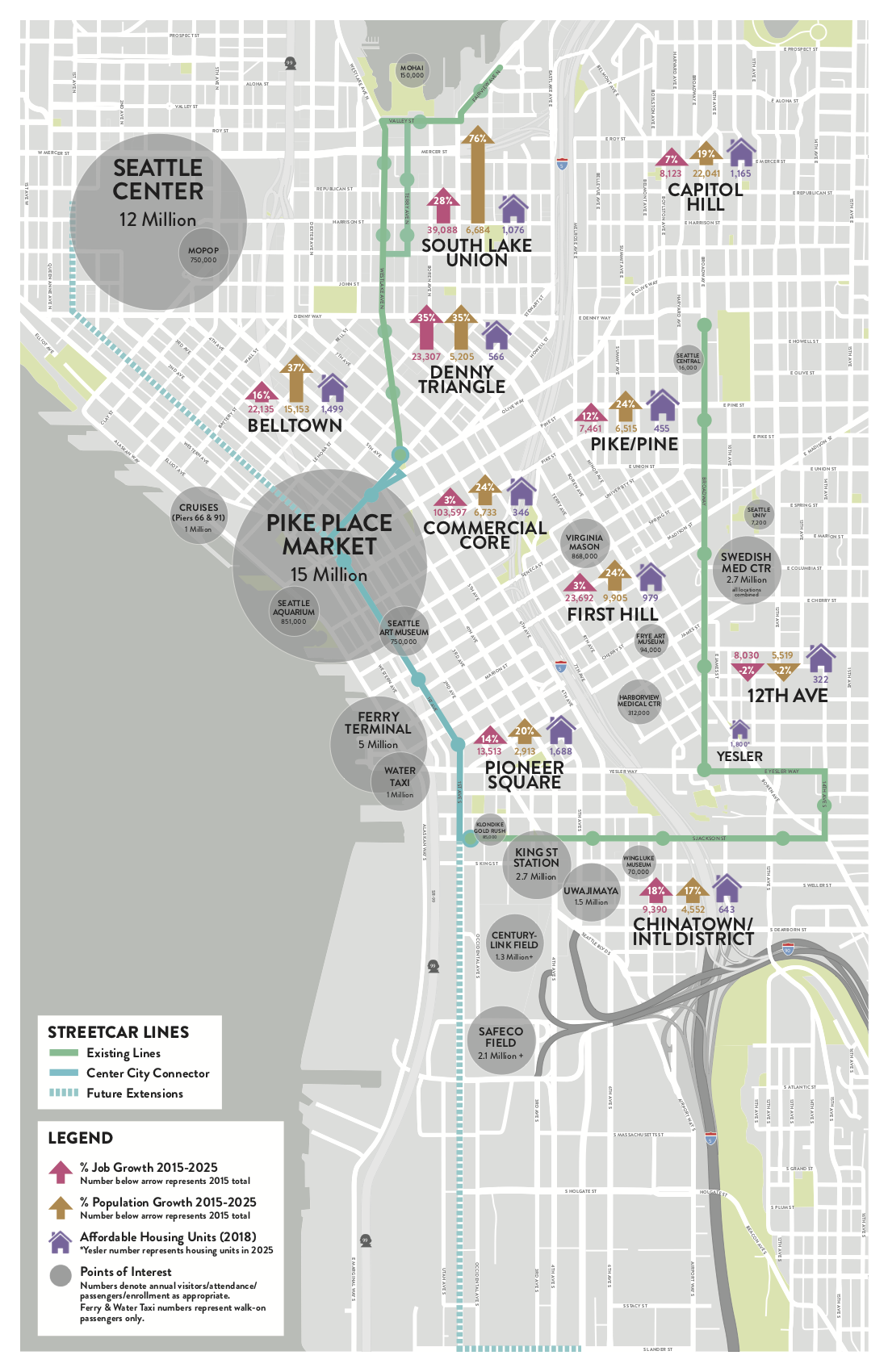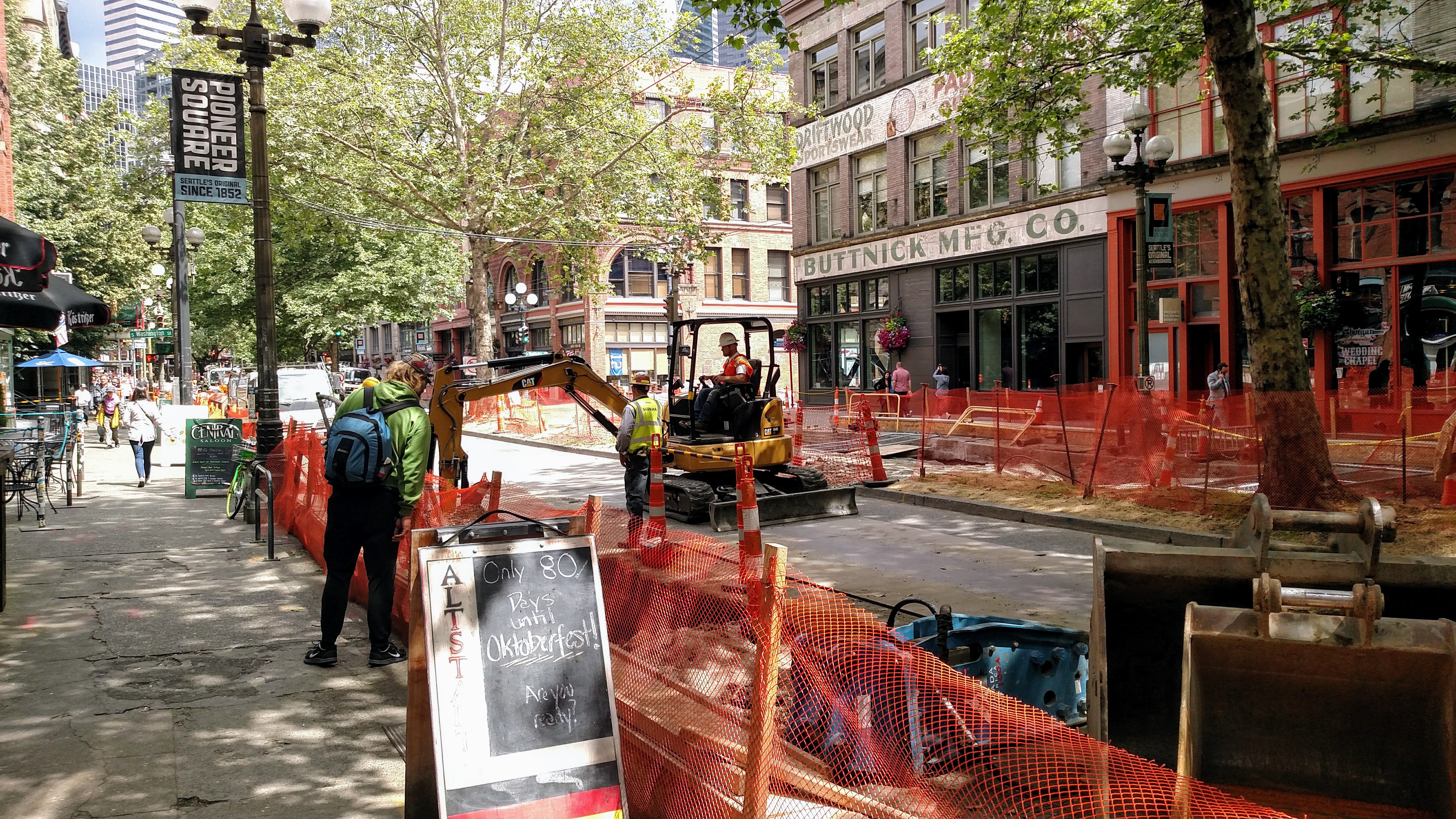
While the city awaits Mayor Jenny Durkan’s decision on the fate of the Center City Connector, scores of business owners, individuals, and organizations have waited for weeks to speak face-to-face with her about the project. On June 19th, the coalition sent a letter to the mayor outlining why the she should complete the project, instead of canceling it and forcing the return of federal dollars. The deadline that the Durkan administration had set for the release of a report, completed by outside consultant KPMG, blew by almost a full month ago with no word from the City on an updated timeline.
It sounds like the KPMG report the mayor is sitting on actually shows daily weekday ridership projections increased from 20,000 in its first year to 25,000 across the streetcar system. Ridership that high would dwarf Seattle’s busiest bus route, the RapidRide E Line, which averaged 17,000 at last count. Mayor Durkan, however, seems to doubt both her own transportation department’s estimates and apparently the independent consultant she just paid $416,000 to check their work.
“So we need to know, before we start a project like that, how much is it going to cost to build, how much is it going to cost to operate, and how many people will it really move, because the goal of transit has got to be to move as many people through Seattle as we can,” Mayor Durkan said in a KUOW interview.
Coalition members, in an email, have expressed a willingness to help trim the budget by finding sensible cost savings for stations and maintenance facility consolidation. Despite their request to speak with the mayor, she has refused to meet with the more than 100 individuals and businesses in the coalition that support the Center City Connector–among them are some notable Durkan backers like former Mayor Charles Royer.
In spelling out their support for streetcar extension, the coalition pointed to its heavy reliance on federal funding and connectedness as a whole system: “We all have skin in the game–Seattle has spent more than $45 [million] on the Center City Connector to date,” the coalition wrote. “The federal government has allocated $75 million for Seattle to complete this project. This is money local leaders have fought hard to protect for years now. Should our city choose to change strategies at this point, the $75 million would get returned.”
The federal money couldn’t just be repurposed to a bus connector service and could result in the federal government penalizing the city by denying future grants, both queued up now like Madison and Roosevelt Rapidride lines and future projects. The city’s D.C. lobbyist has advised against canceling the streetcar for just that reason, even as the mayor seems to play dumb. Future Link light rail projects in Seattle could be among projects that get extra federal scrutiny down the line, too.

The streetcar coalition makes it clear that a unified streetcar system would be vastly better than the existing one of separate, disparate system lines.
“We see the Center City Connector as providing much needed access to jobs for disadvantaged, transit-dependent populations, including service to the federally-supported Yesler Terrace Hope VI housing redevelopment, and remain committed to ensuring that the streetcar is accessible to all in regards to fares and payment systems,” the coalition letter said. “Realizing such a network means that hundreds of minority and family-owned small businesses will have a direct, legible connection to customers that flock to other destinations and attractions in downtown like the Pike Place Market, which sees an estimated 15 million visitors annually. Portland businesses note streetcars account for a 20% increase in traffic to streetcar-adjacent small businesses.”
A recent survey shows that out-of-town tourists spend about $195 per day in Seattle. It’s not a leap to say that a direct connection between Seattle downtown hotspots would bring a larger chunk of that change to minority-owned business along the streetcar corridor if the connector is built.
Meanwhile, the mayor is not applying a racial equity toolkit to the project, but rather fretting over track gauges, for some reason, and the fact the new streetcars would be larger to carry more passengers.
“For example, one of the things we know is that the new streetcars, as designed, are longer than the current ones we have, and heavier,” Mayor Durkan said. “They won’t fit in the maintenance barns, for example, we are not sure if they will fit on the gauge of rail that’s there.”
Coalition supporters include some big names like Uwajimaya, PEMCO Insurance, Seattle University, Vulcan, Argosy Cruises, and Washington State Convention Center, as well as outspoken advocates for the project from the beginning like Transportation Choices Coalition and Downtown Seattle Association. But there are also many local business owners along the line, particularly those in Pioneer Square and Chinatown-International District like Caffe Umbria, Purple Dot Cafe, Jade Garden, Hong Kong Cafe, and Jackson Street Tea Lounge. Several local organizations like Friends of Little Saigon, Seattle Chinatown-International District Preservation and Development Authority, First Hill Improvement Association, and Alliance for Pioneer Square also signed on, making the coalition a deep representation of voices around the center city in favor of the project.
While refusing to meet with this influential coalition, the mayor’s office has been clear they’re meeting with streetcar opponents and listening with rapt attention.

“Since taking office, Mayor Durkan has met and heard from several Pioneer Square businesses regarding transportation challenges downtown, especially as it relates to the streetcar,” Deputy Mayor Mike Fong wrote to the coalition. “She has heard about the real disruption to the neighborhood and the toll that construction has taken on residents and businesses. She has many concerns about both the fiscal impacts as well as the impacts on businesses.”
The city’s handling of the streetcar could become an equity issue as the Pioneer Square business owners that are being heard are largely wealthy white folks, while the ignored pro-streetcar contingent is a diverse coalition including minority business owners from the Chinatown-International District. In fact, when Chinatown-International District was concerned about the impacts from sewer and First Hill Streetcar construction, they were told to grin and bear it, because they would ultimately get a connected streetcar. Stopping this project breaks that promise. It would also break promises made to First Hill of a connected streetcar to replace its light rail station cut from Sound Transit’s plans.
Another signal that the project’s fate could remain in limbo this week was the announcement that the Seattle Department of Transportation will be restoring on-street parking along First Avenue as utility work wraps up that was supposed to dovetail with streetcar construction before the mayor’s delay. As the city awaits word from the mayor on its future transportation network, city crews will be working to put things back how they used to be.
Mayor Durkan Wants More Alternatives to Streetcar Studied, Delaying Budget Review
Ryan Packer has been writing for The Urbanist since 2015, and currently reports full-time as Contributing Editor. Their beats are transportation, land use, public space, traffic safety, and obscure community meetings. Packer has also reported for other regional outlets including BikePortland, Seattle Met, and PubliCola. They live in the Capitol Hill neighborhood of Seattle.

